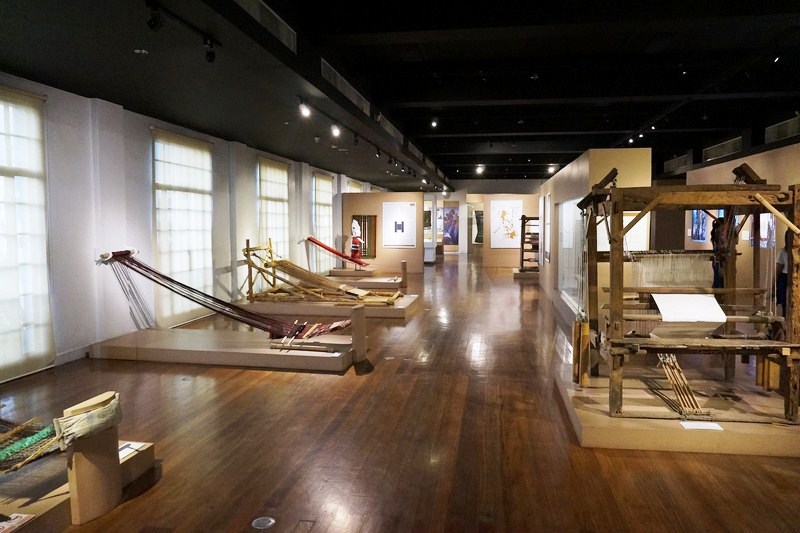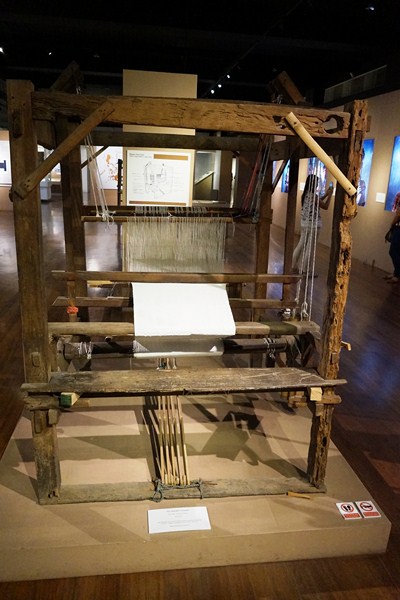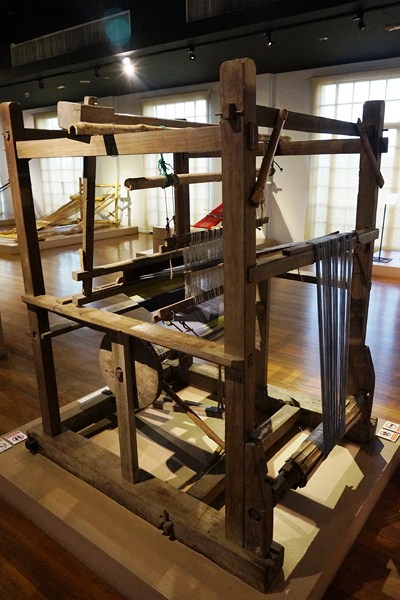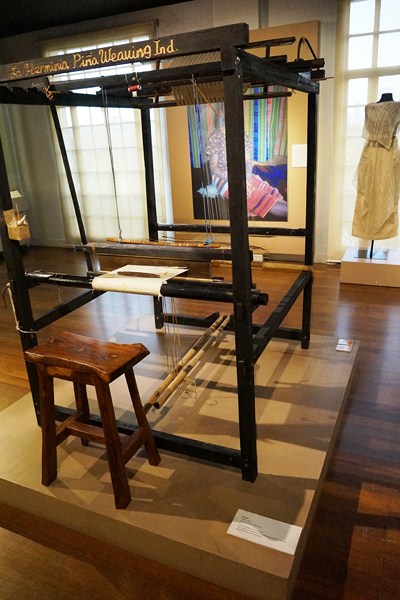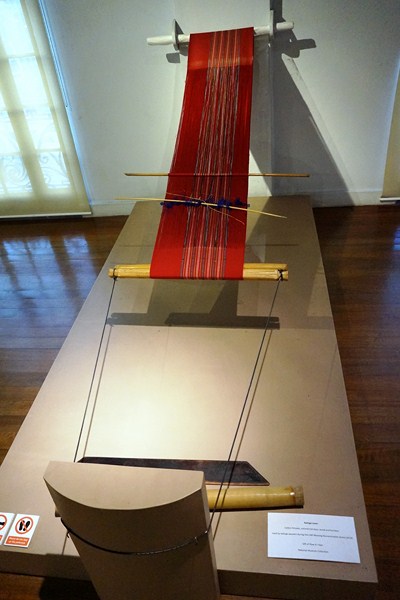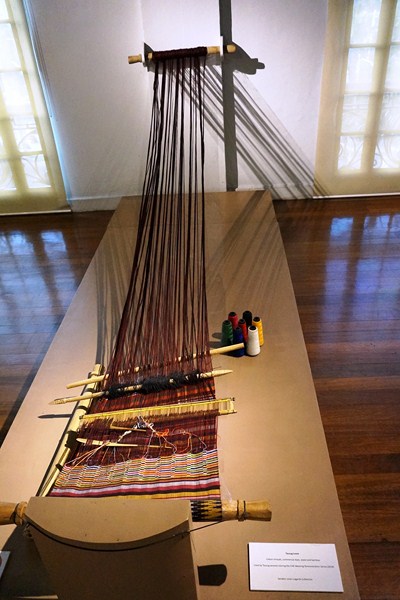The “Hibla ng Lahing Filipino: The Artistry of Philippine Textiles” Exhibit, a project spearheaded by Senator Loren Legarda, was inaugurated on May 18, 2012 and is the first permanent exhibit of the National Museum on traditional Philippine textile weaving, an art that has been performed in the Philippines since pre-colonial times, with each ethnic group having its own particular kind of textile, motifs, and method of production. Highlighting the National Textile Collection, it shows the history and artistry of Philippine textiles.
Check out “National Museum of Anthropology”
Featured are the different textile collections from the National Museum, National Anthropological Collection, and from the private collection of Senator Loren Legarda.
Also seen here are weaving looms (abaca backstrap loom, pina foot loom, etc.) and the intricate process made by our ancestors in designing and producing textile wear from a single simple fiber.

Four sets of traditional native garb in varying shades of red project at the floor-to-ceiling glass case at the entrance. L-R: a two-piece formal female attire worn by the Gaddang of Ifugao; a sa-ul, a set of shirt and trousers traditionally worn by males of the B’laan tribe of Sta. Cruz, Davao del Sur; a more subdued mid-calf-length formal wear of a Tinguian female from Abra; and a brightly hued dagom and sawa worn exclusively by a male Mandaya of high rank in Davao Oriental.
Hibla means “thread” or fiber” and fibers or threads from more than 100 kinds of textiles, including abaca, banana, pineapple and cotton, are seen in the exhibit. The works of more than 100 indigenous groups are also featured.
The exhibit offers a glossy colored catalog that details the stories about each item of clothing, from the source of material to how it is painstakingly handcrafted, the occasion it was worn in and who is allowed by traditional edict to wear it.
For many ethnic groups, weaving is more than a tradition, it is a religious ritual. The t’nalak fabric, woven by the T’boli people (who first tie-dye abaca threads in earth tones before weaving them) was, until World War II, used mainly for special clothing and to denote bride wealth at high-profile weddings of children of datus.
The intricate tapestries of the Tausug’s pis siyabit signified the wearer’s social rank. The tangkulu, a headcloth worn by magani (Bagobo warriors), can display varying shades from chocolate to blood red, depending on the number of lives taken by the wearer.
There are also many tribes that consider fabrics as a form of currency. Among some groups, marriages can be forbidden without the possession of the proper cloth. The T’boli woman was considered low in social status and disallowed from demanding a high bride wealth or dowry if she cannot weave well. Upon reaching 12 years of age, Bontoc girls were required to learn weaving.

Abl’lun (backstrap loom) used by the Mandaya to weave dagmay, the traditional handwoven textile made of lanot (abaca fibers, Musa textilis).
The museum has photos, taken by assistant director and anthropologist Dr. Ana Maria Theresa P. Labrador, of the funeral of a ranking Bontoc male whose status afforded him to wear an exclusive finangulawan of dark cloth designed with an intricate white pattern during his burial.
There are also photos of Filipinos in traditional garb at the 1904 St. Louis Exposition, courtesy of the American Museum of National History archives, as well as modern images of indigenous Filipinos in their tribal wear as well as the evolution of gowns, dresses and Barong Pilipino created by Filipino designers whose artistry enhanced the beauty of the piña, a traditional fiber made from pineapple fiber.
Other native weaves and fabrics on display include blankets and apparel woven by the people of the Cordilleras using a backstrap loom; abaca, silk; balud of the Maranao; abel iloco of Vigan (Ilocos Sur); the Tinguian blankets of Abra; Gaddang garments of Ifugao; textiles of Polomolok (South Cotabato); Maranao garments of Southern Mindanao, the dagmay of the Bagobo of Davao; and the hablon of Iloilo, woven from piña and jusi fibers, cotton and silk (and later manmade fibers),first developed by the people of Miagao in the latter part of the Spanish era.
Aside from garments narrating personal histories, the exhibit also features accessories worn by indigenous peoples. Enclosed in a glass case are necklaces worn by the Gaddang to indicate social status. Materials include beads, cowrie shells, mother of pearl, horn, turtle shell, brass and strings.
“Hibla ng Lahing Filipino: The Artistry of Philippine Textiles” Exhibit: 4/F, National Museum of Anthropology, Agrifina Circle (or Teodoro Valencia Circle, adjacent to the National Museum of Fine Arts building),Padre Burgos Drive, Rizal Park, Ermita, Manila. Tel: (02) 8528-4912 (02) 8527-1232 (Ethnology Division) and (02) 8527-0278. E-mail: nationalmuseumph@gmail.com and nationalmuseumph.anthropology@gmail.com. Open Tuesdays to Sundays, 10 AM – 5 PM. Admission is free.



